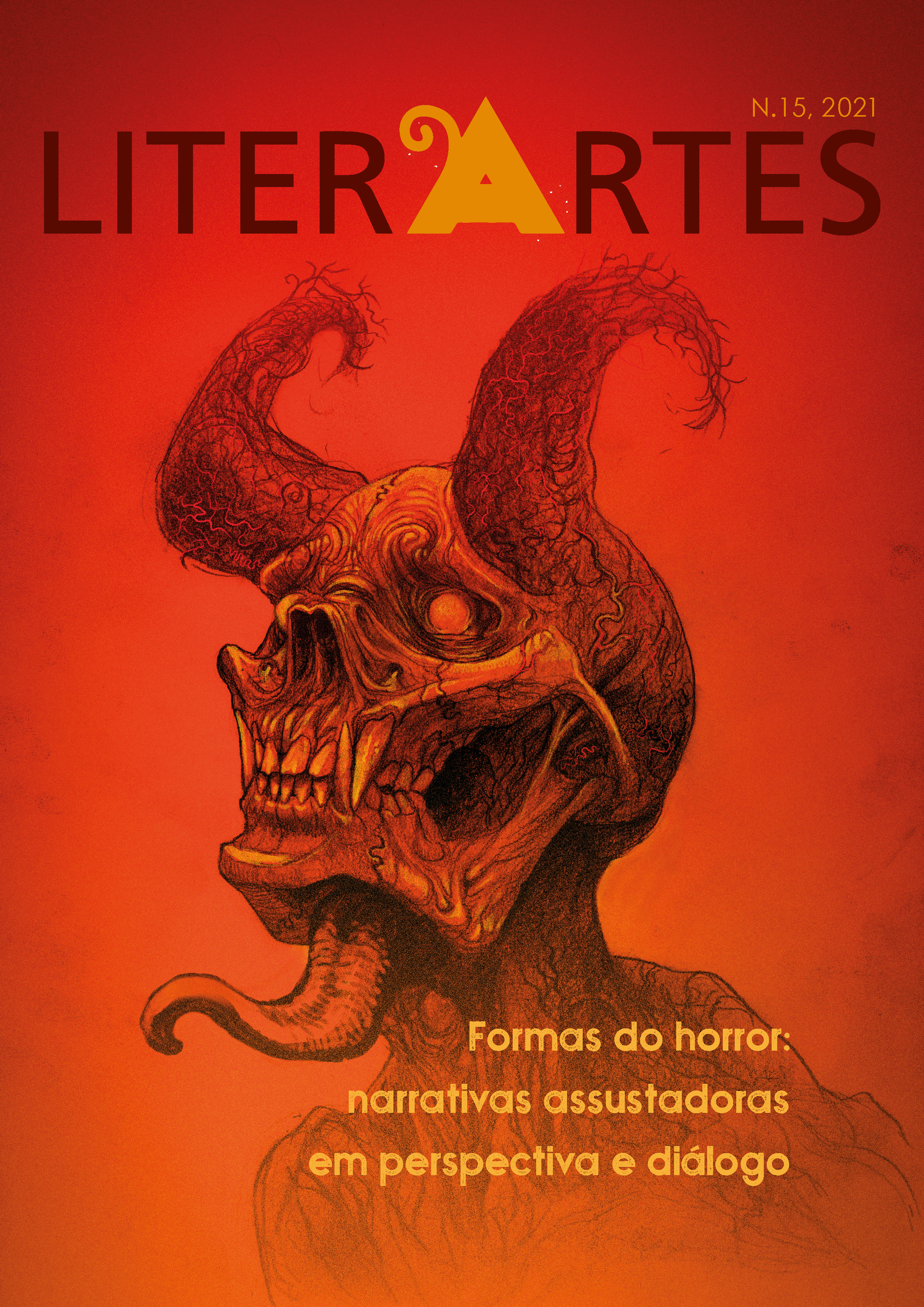Terapia Slasher: o filme Slasher como alegoria do trauma
DOI:
https://doi.org/10.11606/issn.2316-9826.literartes.2021.187620Palavras-chave:
Slasher, Trauma, Psicanálise, A Nightmare on Elmstreet, Final GirlsResumo
O objetivo deste estudo é a análise de filmes slasher como possíveis alegorias para o processo terapêutico da descoberta do trauma, propondo uma leitura do assassino slasher como uma metáfora para o trauma. Para realizar essa análise, os enredos dos filmes A Nightmare on Elm Street (Bayer, 2010) e Final Girls (Schulsson, 2015), foram lidos como possíveis alegorias para o processo psicanalítico em que as protagonistas lidam com seus traumas enquanto enfrentam os assassinos. Esta análise é realizada com base na estrutura do filme slasher formada por Final girl contra o assassino slasher, conforme definida por Carol Clover (1992), e, como o confronto ocorre no lugar chamado por Clover de Terrible place, a questão é comparada ao inconsciente e suas dinâmicas, como proposto Sigmund Freud em The Ego and the Id (2019). A correlação de trauma e narrativas ficcionais é realizada com base na obra de Cathy Caruth (1996) em que é abordada a conexão entre o trauma e a construção de narrativas.
Referências
BACHELARD, Gaston. The Poetics of Space. Boston, Massachussetts: Beacon Press Books, 1994.
CARROLL, Noël. The Philosophy of Horror. New York: Routledge, 1990.
CARUTH, Cathy. “The Wound and the Voice”, In: Unclaimed Experience: Trauma, Narrative, and History, The Johns Hopkins University Press, 1996.
CLOVER, Carol, J. Men, Women and Chain Saws: Gender in the modern horror film. Princeton University Press, 1992.
COHEN, J. J. Monster Theory. Minneapolis: University of Minnesota Press, 1996.
DIKA, Vera. GAMES OF TERROR: A DEFINITION, CLASSIFICATION, AND ANALYSIS OF A SUBCLASS OF THE CONTEMPORARY HORROR FILM, THE STALKER FILM, 1978-1981. New York University Ph.D. 1985.
FREUD, Sigmund. “Beyond the Pleasure Principle”. New York: Liveright Publishing Corporation, 1961.
FREUD, Sigmund. The Ego and the Id. New York, NY: Clydesdale Press, 2019.
FREUD, Sigmund. The Interpretation of Dreams. Hertfortshire: Wordsworth Editions, 1997.
FREUD, Sigmund.The Uncanny. Translated and edited by David McLintock. London, England: Penguin Classics, 2003.
HALBERSTAM, Judith. “Bodies that Splatter: Queers and Chain Saws”, In: Skin Shows: Gothic Horror and the Technoogy of Monsters, Duke University Press Durham and London I995.
KING, Stephen. New York, Danse Macabre, NY: Simon and Schuster, 2011, p.13.
STAIGER, Janet. “The Slasher, the Final Girl and the Anti-Denouement”, In: Style and Form in the Hollywood film, ed. Wickham Clayton. Houndsmill, England: Palgrave Macmillan, 2016, pp. 213-281.
ZANINI, Claudio Vescia. “IT HURTS ’CAUSE YOU’RE IN MY WORLD NOW, BITCH”: GOTHIC FEATURES IN THE 1984 AND 2010 VERSIONS OF A NIGHTMARE ON ELM STREET, In: Ilha do Desterro v. 72, nº 1, p. 199-211, Florianópolis, jan/abr 2019.
ZANINI, Claudio Vescia. “O Perverso e o Gótico em Jogos Mortais”. In: Revista Abusões, Rio de Janeiro, n. 1, v. 1, 2015.
Downloads
Publicado
Edição
Seção
Licença
Copyright (c) 2021 Amanda de Oliveira

Este trabalho está licenciado sob uma licença Creative Commons Attribution-NonCommercial 4.0 International License.
Autores que publicam nesta revista concordam com os seguintes termos:
- Autores mantém os direitos autorais e concedem à revista o direito de primeira publicação, com o trabalho simultaneamente licenciado sob a Licença Creative Commons Attribution que permite o compartilhamento do trabalho com reconhecimento da autoria e publicação inicial nesta revista.
- Autores têm autorização para assumir contratos adicionais separadamente, para distribuição não-exclusiva da versão do trabalho publicada nesta revista (ex.: publicar em repositório institucional ou como capítulo de livro), com reconhecimento de autoria e publicação inicial nesta revista.
- Autores têm permissão e são estimulados a publicar e distribuir seu trabalho online (ex.: em repositórios institucionais ou na sua página pessoal) a qualquer ponto antes ou durante o processo editorial, já que isso pode gerar alterações produtivas, bem como aumentar o impacto e a citação do trabalho publicado (Veja O Efeito do Acesso Livre).



